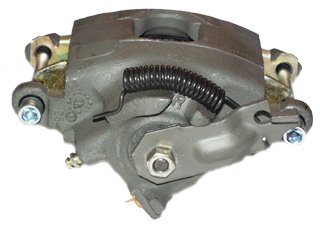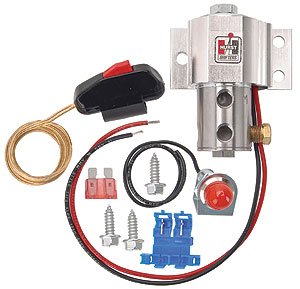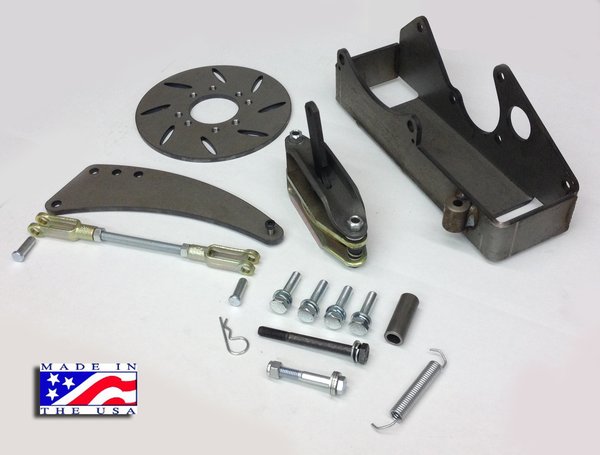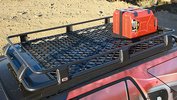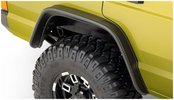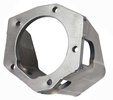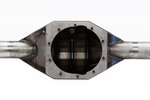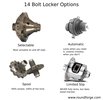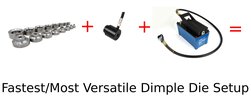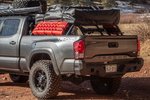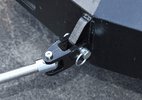4 Ways to Get a Parking or Emergency Brake on Your Toyota Mini or 4Runner
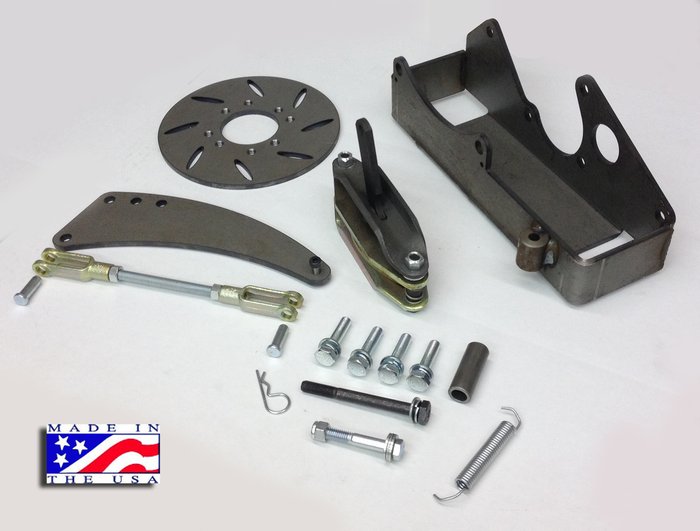
- Toyota 4x4 Brake Master Cylinder and Brake Booster Specs
- 5 Ways to Upgrade Toyota Knuckle Studs
- Your brake lines are not chafing.
- System has no leaks.
- Brakes are properly bled.
- Fluid is clean and filled.
- Wilwood Engineering calipers with built-in e-brake
- Ford Cobra Mustang
- Ford Thunderbird
- Build or buy a disc rotor. It needs to be sized to fit your driveshaft flange and balanced so that your bearings don't get eaten. A lathe would be best for this.
- Build or buy a cable-operated caliper. You can, for instance, buy just the Sky Manufacturing caliper, which is sold as a unit with brake pads.
- Hook up your e-brake cable.
- Generate enough force. You might need to do some testing with the brake lever arm you build to make it the right length. A longer arm will generate more force, but also uses more of the available brake cable travel.
- Keep everything from rattling. Most kits use springs to hold things in place.
E-Brakes and Parking Brakes
The factory drum brake on a Toyota mini, 4Runner, or Tacoma axle has a cable-operated e-brake that pushes the brake shoes out against your brake drum. A properly adjusted factory brake serves two purposes:
1. It holds your truck in place when you need it to stay.
It is never a bad idea to set your brake when you park, but it's way more important when you park on a slope or a hill. Although slapping your truck in gear and then walking away when you park can mostly work for you, if the slope is steep and your truck is heavy enough it can overcome the compression of the engine, which is holding it in place, and start slowly rolling downhill.
2. It's a last resort when you need your truck to stop.
Hopefully, you will never need to use your emergency brake to stop, because it will suck. You'll be stopping with the rear tires, which is inefficient (most braking comes from the front brakes) and you won't have the advantage of vacuum-assist and hydraulic pressure to provide pressure. This is a hard way to stop.
However, a mechanically operated e-brake provides a layer of redundancy to your braking system - you can stop with mechanical force by pulling your e-brake handle. If you lose a hydraulic brake line, which is not unheard of during fourwheeling, your parking/e-brake might be your only option. Hopefully, you'll start to feel the loss of line pressure before it gets to this point.
Why else you might want a working brake
Many organized trail rides have a tech inspection that requires a working e-brake for the reasons above. Beyond that, it just makes things easier. When you park on a slope while you're camping, you don't need to go find a rock or log to stick under your tire. If you need to hook up a trailer, being able to keep the truck exactly where you put it without having manual-trans-rollback will make you much happier.
Parking Brake and Emergency Brake Options
You really should make sure that your primary braking system is in great shape. Especially when we do large brake projects we like to have a quick look at the general brake system for issues. Check the following:
Disc Brake Calipers with Built-In E-Brake
'76-'78 Caddy El Dorado rear brake calipers have an e-brake built-in. We haven't found these to work very well but they might be your last resort.
We don't love these, but you can get brand new ones and they'll get you through tech inspection.
The most common disc brake caliper that goes on the back of a Toyota axle is the one from a Chevy Monte Carlo or similar. There are tons of aftermarket disc brackets floating around for these because they are cheap and relatively easy to adapt to a Toyota axle with Chevy truck brake rotors. The Monte Carlo's do not have an e-brake.
However, the '76-'78 Cadillac El Dorado also uses a similar caliper, but it has a cable-operated e-brake built into it.
It would then appear that you can get a rear disc with e-brake that will bolt onto any aftermarket disc conversion bracket, right?
Well, sort of.
These calipers are notoriously difficult to adjust. Lots of people get frustrated with them and do away with the e-brake operation. They are much more expensive compared to the Monte Carlo's if you buy remanufactured or new calipers.
They are available new, and we'd go that route if we had to use them. Rebuilt El Dorado calipers are usually trash.
You'll need to come up with some custom cabling back to your rear axle, and you might need to try some sort of force multiplication system in order to exert adequate pressure on the calipers. This could be either a pulley system between the factory pull-out e-brake handle and the calipers or a new pull-up style handle mounted to the floor. Either way, you'll need to do some engineering and spend some money to get this working properly.
Other calipers with a built-in e-brake
There are other calipers that might work, but you'll have to do a little research. They are:
If you try one of these or have another solution, let us know how it works out!
Line Lock
The Jamar Line Lock can substitute in for a parking brake by holding line pressure after you've pushed in your brake pedal. It will not slow you in an emergency!
This is more of a "half" option. A Line Lock is like a valve you can install on your hydraulic brake line somewhere. When the valve is closed it holds all the brake fluid in place. When you want to park, you push in your brake pedal, engage the line lock, and your truck will stay in place. It is held with brake pressure and depends on the valve in the line lock holding up. Line locks are not too expensive, but you'll have to tap into your brake hardline. There are two types available:
1. Push Button
The Jamar Line Lock can substitute in for a parking brake by holding line pressure after you've pushed in your brake pedal. It will not slow you in an emergency!
You engage it mechanically, by pushing a button. You have to route a brake line into and out of the cab of your Toyota. This is done by diverting a brake hard line from the engine compartment into the cab, connecting the line lock, then running another hard line back out to where you diverted and hooking back in to your stock hard line. If you do this, ensure that the brake line does not chafe on the body by using insulating grommets where the brake line passes through the body.
2. Electrically-Actuated Solenoid
This kit ties into your front or rear brakes. After you press your brake pedal, flip the switch to keep your rig in place. The solenoid-actuated valve will hold the hydraulic pressure in your brake line.
You engage this electrically with a switch. This line lock can be
installed in the engine compartment. You install it like the push
button by putting it in line with your hardline, but you don't have to route the hardline into your cab. You can then run
wiring into your cab to a conveniently mounted switch so that you can
switch it on and off.
If you buy one of these, remember that you need wiring for power, a switch to turn it on and off, and possibly an indicator light to tell you it's engaged.
Downsides to the Line Lock
The line lock will not work as an emergency brake. Sometimes a line lock will not get you through tech inspection for a trail ride. A hydraulic brake failure is usually a result of a chafed brake line or a line that gets pulled apart, or some sort of destruction (you rip off a link and it smashes your hard line). Since the purpose of an e-brake is to stop your truck when your hydraulic brakes stop functioning a hydraulic valve won't do anything in an emergency stop. If your brake fluid leaks out, there won't be any brake pressure for the line lock to hold.
Since it relies on consistently holding pressure for a prolonged amount of time, you should consider that the line lock or your own braking system could bleed off pressure over time. Therefore, you should always use a high quality line lock and ensure that your braking system's hydraulics are in perfect shape before using a line lock to hold your truck in place.
Installation Woes
One of the biggest complaints we hear about line locks and some other brake parts is that they leak. This is almost always due to the installer not using the correct fittings and not using a proper double flare tool on the brake lines. It's entirely possible to have a brake fitting thread into a part and not seal if the fitting or flare are wrong, so be crystal clear on what you need. To install any line lock you'll need adapter fittings and brake line at a minimum.
Toyota Transfer Case Mounted Parking/Emergency Brake
The Sky Manufacturing transfer case mounted e-brake adds a disc brake to your '79-'95 Toyota 4 cylinder gear case.
This is probably the best option currently available if you have mounted rear disc brakes and you need a parking and emergency brake.
They are only available from Sky Manufacturing and All-Pro Offroad. One of the best things about a t-case mounted e-brake is that it's a proven design and there are several kits on the market to help you keep your truck in place or stop it. Most kits are bolt-in and can be installed in under 2 hours if you're pretty competent with a wrench (Expect to pull off your output flange which takes a 30mm socket.). You can save a substantial amount of time over trying to install El Dorado calipers and you'll have redundancy that you don't get with a line lock.
A t-case mounted e-brake comes in a kit. It has a higher up-front cost than a line lock but probably around the same cost as El Dorado calipers. Considering that you don't need to do any fab work/brake line bending/cable routing using a kit will save you a ton of time and give you an e-brake that is almost equivalent to the stock Toyota drum brake e-brake/parking brake.
Downsides
Requires an intact drivetrain to work
The transfer case mounted brake depends on your transfer case being mechanically connected to your axles, so if you break an axle or driveshaft AND have a hydraulic brake failure, you could be in bad shape. The worst case scenario would be a hydraulic brake failure, sheared driveshaft bolts, and only 2 wheel drive engaged. Still, this is probably better than your other options....
Gear drive t-case required
These are only available for gear drive transfer case. If you don't have one, you need a gear drive transfer case! If you wheel a lot, you'll likely want to upgrade to a gear drive case since all the good stuff gets made for them and they are the strongest factory t-case that is common in Toyotas.
Clearance
A t-case e-brake is a large unit. If you've modded the underside of your 4x4 with a doubler, a new crossmember, a flat belly, or an engine/transmission relocation a t-case e-brake might not be a bolt-on. It's highly dependent on your year and model, but you may have to tweak your fuel lines and some have had to cut the floor. If you have a high clearance doubler setup that swings your case up (like the Marlin MC-R10) or you've swung your transmission/t-case up to have a flat belly, you will be cutting the floor. You can avoid some of the body mods by doing a body lift.
Parts availability
When the rotor, pads, or caliper wear out, you'll need to buy new ones from either Sky or All-Pro. We don't know of other replacement parts that will fit.
Brake is small
Although this type of brake will function if you have a hydraulic brake failure, know that the caliper and rotor are small. This brake does well as a parking brake, but will not do any better than the factory drums as an emergency brake.
Can I make my own t-case e-brake setup?
Yes, but it's a lot of work. Check out this thread on Pirate4x4: T-Case Parking Brake DIY. If you go this route, you need to:
Install a New Axle with Factory Discs and Parking Brake
Installing a rear axle with factory discs and parking brake is somewhat unpioneered territory. There isn't really a sensible, easy-to-find axle that is sized appropriately for Toyota truck and 4Runners with rear disc and parking brake functions. There are also no models of early Toyotas with a factory disc rear axle so you're stuck with either a junkyard axle from another make or you could try to buy a more recent Toyota axle with rear discs. Since a lot of vehicles produced in the last few years have rear disc, it's possible that someone will find a relatively easy swap for Toyota trucks and 4Runners. Here are the issues you'll run into:
You need to adapt the lines and cables.
Toyota trucks, 4Runners, and Tacomas use 10mmx1.0 brake fittings. If your new axle is different, you'll have to source an adapter. This shouldn't be too hard. You'll also need a way to adapt your factory e-brake cable to the new rear axle.
New perches and brackets
Your new axle would need spring perches, shock mounts, and any other stuff that would go on an axle. You'd have to cut off all the old brackets then fabricate and weld on new ones.
The axle will probably be too wide.
Toyota has been making axles wider and wider. An '86-'95 IFS rear axle is 58" wide. A '90-'97 FJ/FZJ80 is 63.5" wide. A third gen 4Runner is 61" wide. If you're using a '79-'85 Toyota front axle, it will be awfully skinny at 55" wide compared to the newer Toyota axles, even with a widening kit. You might run afoul of your state's lift laws and your truck will look weird.
You could cut an axle down, but this makes things very expensive and you'll end up with expensive custom axleshafts.
Weaker parts/Wrong gear ratio
If you can't get gears to match your front axle, you have to run whatever is in your new rear axle. You might end up with a weaker diff or axleshafts than the stock Toyota.
ABS
Newer axles have anti-lock brake systems. You'd need to either make it work or disable it. Most people find a way to disable ABS, but you should investigate whether other people have had luck with a similar swap.
Which should you choose?
If you have discs and you want a parking/emergency brake, your best bet is a transfer case mounted e-brake. This is the closest you'll get to factory function and bolt-in installation. Without significant mods to your Toyota you can bolt it in within an hour.
We would follow that recommendation with a line lock - as long as you understand the line lock's limitations. A line lock will do nothing if you have a hydraulic brake failure.
Last updated: April 16, 2020
